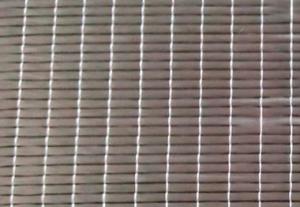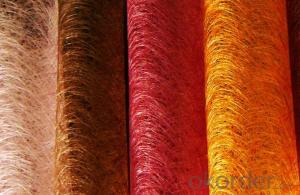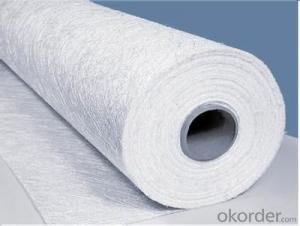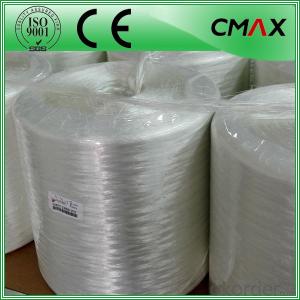Fiberglass Unidirectional fabric 1000gsm 1524mm
- Loading Port:
- Shanghai
- Payment Terms:
- TT or LC
- Min Order Qty:
- 2000 kg
- Supply Capability:
- 30000 kg/month
OKorder Service Pledge
OKorder Financial Service
You Might Also Like
Structure of unidirectional fiberglass fabric Description:
An engineering material, which has many excellent characterstics, such as anti-burning, corrosion resistent, stable structure, heat-isolating, minimum elongated shrinkage, high intensity, etc. This new material product has already covered many domains such as electric appliance, electronic, transportation, chemical engineering, architectural engineering, heat insulation, sound absorption, fire prevention and environmental protection, etc. According to fabric organizational structure and appearance, there are such kind of products: plain weave, twill weave, satin weave, gauze weave.
Main Features of the unidirectional fiberglass fabric:
1)Plain veave,even thickness and low fuzz;
2)High strength in both warp and weft direction;
3)Incombustibility,corrosion resistance and heat resistance;
4)E-Grade Fabric (E-fiberglass Textile Cloth) has excellent electricity insulation property.
Unidirectional fiberglass fabric Images:


Unidirectional Specification:
specifications | Fibre type | 0°Roving | 90°Roving | Overall weight | Width |
(g/㎡) | (g/㎡) | (g/㎡) | (mm) | ||
EDW227 | E-Glass | — | 227 | 227 | 1524 |
EDW350 | E-Glass | — | 350 | 350 | 1524 |
EDW450 | E-Glass | — | 450 | 450 | 1524 |
EDJ600 | E-Glass | 480 | 120 | 600 | 1524 |
EDJ800 | E-Glass | 600 | 200 | 800 | 1524 |
EDJ1000 | E-Glass | 600 | 400 | 1000 | 1524 |
Packaging: Wrapped in PVC and placed within a cardboard carton. | |||||
FAQ of woven roving:
1. Why Choose us?
CNBM is a stated own company, provide the guarantee for the best quality, best service and safety business.
2. How will we guarantee the quality?
a, ISO 9001-2008 quality control system;
b, Strict and regular quality control in production;
c, Inspeciation when loading into container before shippment;
d, Sample stock for one year for quality tracing and record.
3. What is your MOQ?
Our MOQ is one pallet.
4. Can you provide sample?
Yes, samples are in stock. we can offer free sample for you.
5. Payment terms?
We can accept L/C, T/T etc.
6. Do you offer OEM service?
Yes, we can print customers’ logo on the packaging;
And the size and specification can be produced and design according to your demand.
- Q:Is fiberglass mat tissue suitable for automotive interiors?
- Yes, fiberglass mat tissue can be suitable for automotive interiors. Fiberglass mat tissue is a versatile material that is commonly used in various industries, including automotive manufacturing. It offers several benefits that make it suitable for automotive interiors. Firstly, fiberglass mat tissue provides excellent insulation properties. It helps in reducing noise, vibration, and harshness (NVH) levels inside the vehicle cabin. This can significantly enhance the overall comfort and driving experience for passengers. Secondly, fiberglass mat tissue is lightweight and flexible, making it easy to install in different areas of the car interior. It can be molded and shaped to fit various parts, such as door panels, headliners, trunk liners, and floor carpets. Its flexibility also allows for easy integration with other components, such as sound-deadening materials, to further improve insulation and reduce vibrations. Additionally, fiberglass mat tissue is resistant to heat, moisture, and chemicals, which are often present in automotive environments. This makes it a durable and long-lasting material that can withstand the unique conditions inside a vehicle. It is also resistant to mold and mildew growth, ensuring a clean and hygienic interior. Furthermore, fiberglass mat tissue can be easily coated or laminated with other materials to enhance its aesthetic appeal. It can be finished with various fabrics, vinyl, or leather to match the desired interior design and provide a luxurious feel. In summary, fiberglass mat tissue is a suitable material for automotive interiors due to its insulation properties, lightweight and flexible nature, durability, resistance to heat and moisture, and potential for aesthetic enhancements. Its usage can contribute to creating a comfortable, quiet, and visually appealing cabin space for vehicle occupants.
- Q:What is the thermal conductivity of fiberglass mat tissue?
- The thermal conductivity of fiberglass mat tissue is typically low, ranging from 0.03 to 0.05 W/m·K. This means that fiberglass mat tissue is a good insulator and can effectively resist the transfer of heat. Its low thermal conductivity makes it suitable for applications such as thermal insulation in buildings, industrial equipment, and appliances.
- Q:How does fiberglass mat tissue perform in terms of UV resistance?
- The UV resistance of fiberglass mat tissue is generally good. UV resistance refers to a material's ability to endure the harmful consequences of ultraviolet radiation without deteriorating. Fiberglass mat tissue is typically made by combining fiberglass and a binder material, which gives it strength and integrity. The fiberglass in the mat tissue inherently possesses UV resistance. Fiberglass is recognized for its durability and its capability to resist deterioration caused by UV exposure. It is a non-absorbent material that does not soak up UV radiation, making it less prone to damage from the sun's rays. Moreover, certain manufacturers may apply a UV-resistant coating or treatment to enhance the UV resistance of the fiberglass mat tissue. This additional coating or treatment offers extra protection against the harmful effects of extended UV radiation exposure. In general, fiberglass mat tissue performs admirably when it comes to UV resistance. It is a sturdy material that can endure the harmful consequences of UV radiation, making it suitable for situations where prolonged exposure to sunlight is anticipated. However, it is important to note that the specific UV resistance of fiberglass mat tissue can vary depending on factors such as the manufacturing process, the quality of materials used, and any additional coatings or treatments applied.
- Q:Can fiberglass mat tissue be used for wall insulation?
- No, fiberglass mat tissue is not typically used for wall insulation. It is more commonly used in applications such as reinforcing and adding strength to composite materials like fiberglass panels or laminates. For wall insulation, other materials like fiberglass batts, mineral wool, or foam boards are typically used.
- Q:Is fiberglass mat tissue fire-resistant?
- No, fiberglass mat tissue is not inherently fire-resistant. While fiberglass itself is a non-combustible material, fiberglass mat tissue is typically combined with a binder or resin that may be flammable. However, specialty fiberglass mat tissue products are available that have been treated with fire-resistant coatings or additives to enhance their fire resistance properties. These treated materials can provide improved fire resistance and are commonly used in applications where fire safety is a concern, such as in certain construction or insulation materials. It is important to review the specific product specifications or consult with the manufacturer to determine the fire resistance capabilities of a particular fiberglass mat tissue.
- Q:Is fiberglass mat tissue resistant to oil and grease?
- Indeed, oil and grease do not affect fiberglass mat tissue due to its resistance. The structure of this tissue encompasses delicate glass fibers, tightly bound by a resin. This resin serves as a protective shield, prohibiting the penetration of oil and grease into the mat tissue, thus granting it resistance against these substances. Moreover, fiberglass possesses inherent non-reactive characteristics, amplifying its ability to withstand oil and grease. Consequently, fiberglass mat tissue proves to be an exemplary material for circumstances involving anticipated contact with oil and grease, such as industrial environments or automotive components.
- Q:What are the different methods of bonding fiberglass mat tissue to other materials?
- There are several methods of bonding fiberglass mat tissue to other materials, including mechanical bonding, chemical bonding, and thermal bonding. Mechanical bonding involves using adhesives or fasteners to physically attach the fiberglass mat tissue to the other material. Chemical bonding involves using a bonding agent or adhesive that chemically reacts with both the fiberglass mat tissue and the other material, creating a strong bond. Thermal bonding involves using heat to melt the fiberglass mat tissue and fuse it with the other material, creating a cohesive bond.
- Q:Is fiberglass mat tissue suitable for automotive panel repairs?
- Automotive panel repairs can be effectively carried out using fiberglass mat tissue. This material is known for its versatility and durability, making it a popular choice in the automotive industry. It proves particularly useful in reinforcing and restoring weakened or damaged areas on automotive panels. By providing a strong and stable foundation, fiberglass mat tissue is capable of repairing dents, cracks, and holes in panels. Its pliability allows for easy shaping and molding to fit the contour of the panel. Furthermore, fiberglass mat tissue's resistance to rust and corrosion makes it a reliable option for automotive repairs that must endure harsh weather conditions and road debris. Overall, fiberglass mat tissue is widely utilized due to its strength, durability, and versatility, making it an ideal choice for automotive panel repairs.
- Q:Can fiberglass mat tissue be used for roofing?
- Roofing can indeed utilize fiberglass mat tissue. This material is frequently employed in the construction industry for a multitude of purposes, including roofing. It is renowned for its robustness, durability, and ability to endure harsh weather conditions. In roofing systems, fiberglass mat tissue often serves as a reinforcing layer, bestowing added strength and stability to the roof. By offering exceptional resistance to water, fire, and external factors, it significantly enhances the roof's overall performance and lifespan. Moreover, fiberglass mat tissue is lightweight and flexible, facilitating its handling and installation on roofs of varying shapes and sizes. Ultimately, due to its exceptional properties and performance, fiberglass mat tissue proves to be a fitting choice for roofing applications.
- Q:Can fiberglass mat tissue be used for repairing fiberglass shower stalls?
- Certainly! Fiberglass mat tissue is an excellent choice for fixing fiberglass shower stalls. It is a flexible material that is widely utilized for reinforcing and mending various fiberglass structures, such as shower stalls. Its purpose is to enhance the strength and resilience of the repaired section, guaranteeing a durable and dependable solution. By pairing fiberglass mat tissue with compatible fiberglass resin, one can effectively mend cracks, holes, and other impairments in fiberglass shower stalls. Nevertheless, it is vital to diligently adhere to the instructions and recommendations provided by the manufacturer to achieve optimal outcomes in terms of application and curing.
1. Manufacturer Overview |
|
|---|---|
| Location | |
| Year Established | |
| Annual Output Value | |
| Main Markets | |
| Company Certifications | |
2. Manufacturer Certificates |
|
|---|---|
| a) Certification Name | |
| Range | |
| Reference | |
| Validity Period | |
3. Manufacturer Capability |
|
|---|---|
| a)Trade Capacity | |
| Nearest Port | |
| Export Percentage | |
| No.of Employees in Trade Department | |
| Language Spoken: | |
| b)Factory Information | |
| Factory Size: | |
| No. of Production Lines | |
| Contract Manufacturing | |
| Product Price Range | |
Send your message to us
Fiberglass Unidirectional fabric 1000gsm 1524mm
- Loading Port:
- Shanghai
- Payment Terms:
- TT or LC
- Min Order Qty:
- 2000 kg
- Supply Capability:
- 30000 kg/month
OKorder Service Pledge
OKorder Financial Service
Similar products
New products
Hot products
Hot Searches
Related keywords





























